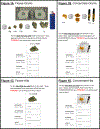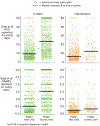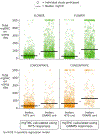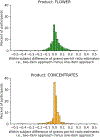Exploring survey methods for measuring consumption quantities of cannabis flower and concentrate products
- PMID: 37774316
- PMCID: PMC10795727
- DOI: 10.1080/00952990.2023.2246635
Exploring survey methods for measuring consumption quantities of cannabis flower and concentrate products
Abstract
Background: Researchers need accurate measurements of cannabis consumption quantities to assess risks and benefits. Survey methods for measuring cannabis flower and concentrate quantities remain underdeveloped.Objective: We examined "grams" and "hits" units for measuring flower and concentrate quantities, and calculating milligrams of THC (mgTHC).Methods: Online survey participants (n = 2,381) reported preferred unit (hits or grams), past-week hits and grams for each product, and product %THC. Quantile regression compared mgTHC between unit-preference subgroups. Hits-based mgTHC calculations assumed a universal grams-per-hit ratio (GPHR). To examine individualized GPHRs, we tested a "two-item approach," which divided total grams by total hits, and "one-item approach," which divided 0.5 grams by responses to the question: "How many total hits would it take you to finish 1/2 g of your [product] by [administration method]?"Results: Participants were primarily daily consumers (77%), 50% female sex, mean age 39.0 (SD 16.4), 85% White, 49% employed full-time. Compared to those who preferred the hits unit, those who preferred the grams unit reported consuming more hits and grams, higher %THC products, and consequently, larger median mgTHC (flower-hits mgTHC: 32 vs. 91 (95%CI: 52-67); flower-grams mgTHC: 27 vs. 113 (95%CI: 73-95); concentrate-hits mgTHC: 29 vs. 59 (95%CI: 15-43); concentrate-grams mgTHC: 61 vs. 129 (95%CI: 43-94)). "Two-item" and "one-item" approach GPHRs were similar and frequently 50% larger or smaller than the universal GPHR.Conclusion: Allowing respondents to choose "hits" or "grams" when reporting cannabis quantities does not compromise mgTHC estimates. A low-burden, one-item approach yields individualized "hit sizes" that may improve mgTHC estimates.
Keywords: Cannabis; THC; measurement; quantity; survey.
Figures




References
-
- Lee DC, Schlienz NJ, Peters EN, Dworkin RH, Turk DC, Strain EC, Vandrey R. Systematic review of outcome domains and measures used in psychosocial and pharmacological treatment trials for cannabis use disorder. Drug Alcohol Depend. 2019;194:500–517. doi: 10.1016/j.drugalcdep.2018.10.020. - DOI - PMC - PubMed
-
- Loflin MJE, Kiluk BD, Huestis MA, Aklin WM, Budney AJ, Carroll KM, D’Souza DC, Dworkin RH, Gray KM, Hasin DS, et al. The state of clinical outcome assessments for cannabis use disorder clinical trials: A review and research agenda. Drug Alcohol Depend. 2020;212:107993. doi: 10.1016/j.drugalcdep.2020.107993. - DOI - PMC - PubMed
Publication types
MeSH terms
Substances
Grants and funding
LinkOut - more resources
Full Text Sources
Miscellaneous
